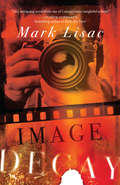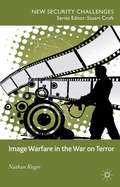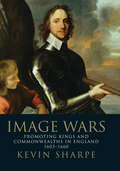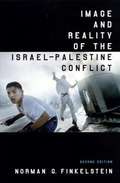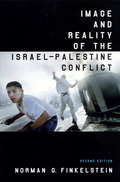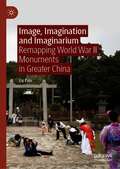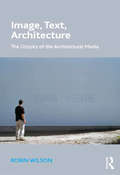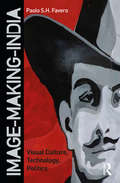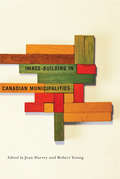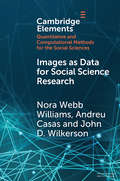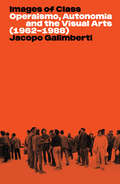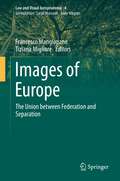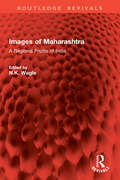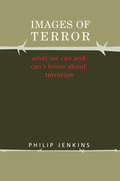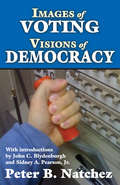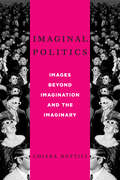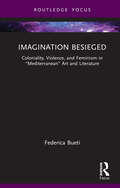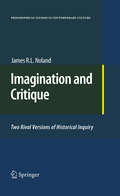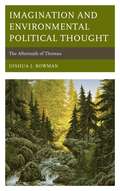- Table View
- List View
Image Decay
by Mark LisacMark Lisac’s Image Decay returns to the pugnacious world of backroom politics laid out in his award-nominated Where the Bodies Lie. Set again in that “unnamed capital city east of the Rockies,” where the Brutalist architecture of the downtown core reflects the body politic laid bare.When a cantankerous ex-government photographer seeks ownership of his prints, the powers-that-be are determined to prevent the release of certain sensitive photos. Set in the 1990s, this political thriller delves into questions of identity and memory, established power and its fears and secrets, old stock versus newcomers, belonging and alienation.Image Decay investigates the intricacies of political manipulation, personal anxieties, and how history must be seen to be confronted.
Image Warfare in the War on Terror
by Nathan RogerRoger examines how developments in new media technologies, such as the internet, blogs, camera/video phones, have fundamentally altered the way in which governments, militaries, terrorists, NGOs, and citizens engage with images. He argues that there has been a paradigm shift from techno-war to image warfare, which emerged on 9/11.
Image Wars: Kings and Commonwealths in England, 1603-1660
by Kevin SharpeSpin and photo opportunities may appear to have emerged onto the political scene only recently, but in fact image and its manipulation have always been vital to the authority of rulers. This book, the second in Kevin Sharpe's trilogy exploring image, power, and communication in early modern England, examines its importance during the turbulent seventeenth century. From the coronation of James I to the end of Cromwell's protectorate, Sharpe considers how royalists and parliamentarians--often using the same vocabularies--sought to manage their public image through words, pictures, and performances in order to win support and secure and enhance their authority.
Image and Reality of the Israel Palestine Conflict (2nd edition)
by Norman G. FinkelsteinFirst published in 1995, this polemical study challenges generally accepted truths of the Israel-Palestine conflict as well as much of the revisionist literature. This new edition critically re-examines dominant popular and scholarly images in the light of the current failures of the peace process.
Image and Reality of the Israel-Palestine Conflict
by Norman FinkelsteinThis acclaimed study surveys the dominant popular and scholarly images of the Israel-Palestine conflict. Finkelstein opens with a theoretical discussion of Zionism, locating it as a romantic form of nationalism that assumed the bankruptcy of liberal democracy. He goes on to look at the demographic origins of the Palestinians, with particular reference to the work of Joan Peters, and develops critiques of the influential studies of both Benny Morris and Anita Shapira. Reviewing the diplomatic history with Aban Eban's oeuvre as his foil, Finkelstein closes by demonstrating that the casting of Israel as the innocent victim of Arab aggression in the June 1967 and October 1973 wars is not supported by the documentary record. This new edition critically reexamines dominant popular and scholarly images in the light of the current failures of the peace process.From the Trade Paperback edition.
Image of America
by R. L. Bruckberger"Either America is the hope of the world, or it is nothing. There are those who have begun to despair of the West. It is for them that I am writing." Thus the author states his intention. The result is a book -- in the tradition of Tocqueville and Bryce -- in which we see ourselves through the sympathetic, critical eyes of a Frenchman who as Chaplain General of the Resistance has seen the life of action and as scholar, author, and priest knows the life of the spirit. He lived for eight years in this country, thought deeply about it, and came to love and admire it. His eyes and ears picked up sights and sounds that ours do not. The heroes he admires are not, in most instances, the ones we should choose. The ideas and ideals that have shaped our history and our character as a nation, seen in the perspective of the ancient traditions of Europe, take on a new meaning. From hitherto unused or misused material an image of America emerges that is as enlightening as it is surprising. "To some of the problems that most torment the European conscience," Father Bruckberger writes, "America, I am convinced, has found answers, and found them with no disavowal of the European heritage. America brings to this Western heritage something concrete of its own. . . ." How has this come about? What is the essential spark that has won so vital a role for this country in the angry and perilous world of today? The answer, says the author, lies in our regard for the individual, for the non-abstract, living human being. This theme, contrasted with the heresy of Europe (the subordination of Man to abstraction), is developed with wit and insight in the author's reflections on our political principles and institutions, on our economic beliefs, and on our business and social achievements.
Image, Imagination and Imaginarium: Remapping World War II Monuments in Greater China
by Lu PanThis book explores five cases of monument and public commemorative space related to World War II (WWII) in contemporary China (Mainland), Hong Kong and Taiwan, all of which were built either prior to or right after the end of the War and their physical existence still remains. Through the study on the monuments, the project illustrates past and ongoing controversies and contestations over Chinese nation, sovereignty, modernism and identity. Despite their historical affinities, the three societies in question, namely, Mainland China, Hong Kong and Taiwan, vary in their own ways of telling, remembering and forgetting WWII. These divergences are not only rooted in their different political circumstances and social experiences, but also in their current competitions, confrontations and integrations. This book will be of great interest to historians, sinologists and analysts of new Asian nationalism.
Image, Text, Architecture: The Utopics of the Architectural Media
by Robin WilsonImage, Text, Architecture brings a radical and detailed analysis of the modern and contemporary architectural media, addressing issues of architectural criticism, architectural photography and the role of journal editors. It covers examples as diverse as an article by British artist Paul Nash in The Architectural Review, 1940, an early project by French architects Lacaton & Vassal published in the journal 2G, 2001, and recent photography by Hisao Suzuki for the Spanish journal El Croquis. At the intersection of image and text the book also reveals the role of the utopian impulse within the architectural media, drawing on theories of utopian discourse from the work of the French semiotician and art theorist Louis Marin, and the American Marxist critic Fredric Jameson. Through this it builds a fresh theoretical approach to journal studies, revealing a hitherto unexplored dimension of "latent" or "unconscious" discourse within the media portrait of architecture. The purpose of this enquiry is to highlight moments where a different type of critical voice emerges on the architectural journal page, indicating the possibility of a more progressive engagement with the media as a platform for critical and speculative thinking about architecture, and to rethink the journals’ role within architectural history.
Image-Making-India: Visual Culture, Technology, Politics
by Paolo FaveroImage-Making-India explores the evolving meaning of images in a digital landscape from the vantage point of contemporary India. Building upon long-term ethnographic research among image-makers in Delhi, Mumbai and other Indian cities, the author interrogates the dialogue between visual culture, technology and changing notions of political participation. The book explores selected artistic experiences in documentary and fiction film, photography, contemporary art and digital curation that have in common a desire to engage with images as tools for social intervention. These experiences reveal images’ capacity not only to narrate and represent but also to perform, do and affect. Particular attention is devoted to the 'digital', a critical landscape that offers an opportunity to re-examine the significance of images and visual culture in a rapidly changing India. This volume will be of particular interest to scholars of visual and digital anthropology and cultures as well as South Asian studies.
Image-building in Canadian Municipalities
by Robert Young Jean HarveyMunicipal image-building now promotes cities globally, and also to their own citizens. Image-building in Canadian Municipalities explores the decision making processes that determine how cities and towns choose to represent themselves. It also assesses the effectiveness of those processes and of the images themselves. Documenting how image-building policies vary across municipalities and provinces, contributors focus on the interaction between various levels of government and on the involvement and influence of business organizations, heritage associations, environmental groups, and other social forces. Delving into largely unexplored areas of research, with a particular interest in smaller towns and cities, authors show how municipal image-making is often used to advance other policy objectives, and thereby intersects with areas such as culture, economic development, tourism, and immigration. Image-building in Canadian Municipalities shows how municipalities of all sizes are conscious of their images. Thought-provoking and instructive, it provides lessons to policy makers and social interest groups about creating better public policies. Contributors include Caroline Andrew (University of Ottawa), John C. Lehr (University of Winnipeg), Judy Lynn Richards (University of Prince Edward Island), Cristine de Clercy (University of Western Ontario), Peter Ferguson (University of Western Ontario), and Karla Zubrycki International Institute for Sustainability, Winnipeg).
Image-building in Canadian Municipalities (Fields of Governance: Policy Making in Canadian Municipalities #4)
by Robert Young Jean HarveyMunicipal image-building now promotes cities globally, and also to their own citizens. Image-building in Canadian Municipalities explores the decision making processes that determine how cities and towns choose to represent themselves. It also assesses the effectiveness of those processes and of the images themselves. Documenting how image-building policies vary across municipalities and provinces, contributors focus on the interaction between various levels of government and on the involvement and influence of business organizations, heritage associations, environmental groups, and other social forces. Delving into largely unexplored areas of research, with a particular interest in smaller towns and cities, authors show how municipal image-making is often used to advance other policy objectives, and thereby intersects with areas such as culture, economic development, tourism, and immigration. Image-building in Canadian Municipalities shows how municipalities of all sizes are conscious of their images. Thought-provoking and instructive, it provides lessons to policy makers and social interest groups about creating better public policies. Contributors include Caroline Andrew (University of Ottawa), John C. Lehr (University of Winnipeg), Judy Lynn Richards (University of Prince Edward Island), Cristine de Clercy (University of Western Ontario), Peter Ferguson (University of Western Ontario), and Karla Zubrycki International Institute for Sustainability, Winnipeg).
Images as Data for Social Science Research: An Introduction to Convolutional Neural Nets for Image Classification (Elements in Quantitative and Computational Methods for the Social Sciences)
by John D. Wilkerson Nora Webb Williams Andreu CasasImages play a crucial role in shaping and reflecting political life. Digitization has vastly increased the presence of such images in daily life, creating valuable new research opportunities for social scientists. We show how recent innovations in computer vision methods can substantially lower the costs of using images as data. We introduce readers to the deep learning algorithms commonly used for object recognition, facial recognition, and visual sentiment analysis. We then provide guidance and specific instructions for scholars interested in using these methods in their own research.
Images from Paradise: The Visual Communication of the European Union's Federalist Utopia
by Eszter SalgóDrawing upon the disciplines of politics, anthropology, psychoanalysis, aesthetics and cinema studies, Salgó presents a new way of looking at the "art of European unification." The official visual narratives of the European Union constitute the main object of inquiry – the iconography of the new series of euro banknotes and the videos through which the supranational elite seek to generate "collective effervescence," allow for a European carnival to take place, and prompt citizens to pledge allegiance to the sacred dogma of the "ever closer union," thereby strengthening the mythical sources of the organization's legitimacy. The author seeks to illustrate how and why the federalist utopia turned into a political soteriology after the outbreak of the 2008 crisis.
Images of Anarchy
by Ioannis D. EvrigenisHobbes's concept of the natural condition of mankind became an inescapable point of reference for subsequent political thought, shaping the theories of emulators and critics alike, and has had a profound impact on our understanding of human nature, anarchy, and international relations. Yet, despite Hobbes's insistence on precision, the state of nature is an elusive concept. Has it ever existed and, if so, for whom? Hobbes offered several answers to these questions, which taken together reveal a consistent strategy aimed at providing his readers with a possible, probable, and memorable account of the consequences of disobedience. This book examines the development of this powerful image throughout Hobbes's works, and traces its origins in his sources of inspiration. The resulting trajectory of the state of nature illuminates the ways in which Hobbes employed a rhetoric of science and a science of rhetoric in his relentless pursuit of peace.
Images of Class: Operaismo, Autonomia and the Visual Arts (1962-1988)
by Jacopo GalimbertiThe first overview of the unique encounter between artists and the prominent Marxist current Workerism, also known as OperaismoDuring the 1960s and 1970s, Workerism and Autonomia were prominent Marxist currents. However, it is rarely acknowledged that these movements inspired many visual artists such as the members of Archizoom, Gordon Matta-Clark and Gianfranco Baruchello. This book focuses on the aesthetic and cultural discourse developed by three generations of militants (including Mario Tronti, Antonio Negri, Bifo and Silvia Federici), and how it was appropriated by artists, architects, graphic designers and architectural historians such as Manfredo Tafuri. Images of Classsignposts key moments of this dialogue, ranging from the drawings published on classe operaia to Potere Operaio&’s exhibition in Paris, the Metropolitan Indians&’ zines, a feminist art collective who adhered to the Wages for Housework Campaign, and the N group&’s experiments with Gestalt theory. Featuring more than 140 images of artworks, many published here for the first time, this volume provides an original perspective on post-war Italian culture and new insights into some of the most influential Marxist movements of the twentieth and twenty-first centuries worldwide.
Images of Europe: The Union between Federation and Separation (Law and Visual Jurisprudence #4)
by Francesco Mangiapane Tiziana MiglioreThis book deals with the fundamental semantics of images of Europe, which consist of valences, mirror beliefs and affectivities. This is why it relaunches the importance of the European discourse in its symbolic dimension. As such, it explores the many images of Europe, or rather the many images through which European discourse is actually constituted in daily life, in search of their enunciative responsibility in today’s world for determining the current “State of the Union”. The identity of the European continent is based on a millenary tension between universalism and particularism: images of Europe have in fact been alternately inspired, over the centuries, by a model of homogeneity – Roman and Carolingian imperial disposition – on the one hand, and by a model of fragmentation – a Europe of city-states, municipalities, regions and small fatherlands – on the other. In the European Union, a political and economic organism, this issue has recently been amplified to the point that it has reentered public debate, and political parties that are only recognizable for being Europeanists or anti-Europeanists are now ubiquitous. In this regard, one major bone of contention is how to portray the quintessential aspects of the European territory, which are either interpreted as “thresholds” to be overcome in the name of a model of United Europe – “integral totality” – or are instead regarded as insurmountable obstacles for a Europe that is irreparably and perhaps, according to anti-Europeanists, fortunately fragmented – “partitive totality”. Further, this is to be done without excluding the possibility of contradictory and complementary solutions to these binary visions. In this context the book analyzes various texts in order to obtain a more precise picture of the clash, reveal its semiotic forms, and by doing so, identify a way out of the crisis.
Images of Maharashtra: A Regional Profile of India (Routledge Revivals)
by N. K. WagleFirst published in 1980, Images of Maharashtra presents the authors’ academic interests in defining the multifaceted personality of Maharashtra. All the papers were presented at the Annual Conferences of Maharashtra Studies Group of the Association for Asian Studies. They range over history, politics, agriculture, sociology, and religion.Milton Israel discusses M.R. Jayakar’s use of English language newspaper of Bombay for the Nationalist cause; Mary Katzenstein examines the government’s response to migration; B.G. Gokhale stresses on the importance of Urban commercial centres of Western Deccan in the 17th century; and Donald Innis’ paper is a tribute to creative efforts of the ‘peasant scientists’. Jayant Lele explores the class, caste and hegemony in rural Maharashtra and Jayshree Gokhale-Turner focuses on the importance of Maharashtra region as a structural unit of study. L.W. Preston presents a historical analysis of the subregional religious centres and N.K. Wagle examines the dilemma of early 19th century British administrators in coping with the problem of social rank. This book will be of interest to students and researchers of Asian studies.
Images of Terror: What We Can and Can't Know about Terrorism (Social Problems And Social Issues Ser.)
by R.L. BruckbergerThe book acts as a guide to the images of terrorism that we see daily in the mass media. The author believes that our perceptions of terrorism are formed by the interaction of bureaucratic agencies, academics and private experts. These images and stereotypes that we are offered do not necessarily reflect objective reality.
Images of Voting/Visions of Democracy
by Peter NatchezWhen survey research, statistics, and electronic data processing were first introduced, they held out promise that a new level of political knowledge would be created. Applied to the study of voting behavior, survey research promised an understanding of the factors determining the outcome of an election, that political history could be based on rich and current data, and that we could begin to understand the role of elections in constitutional democracy. The truth as Peter B. Natchez shows, is that despite the opportunity provided by this revolution, voting studies have failed to make significant contributions to democratic theory or political history.The findings of voting studies have spread from the universities into the political system with a rather grim message. In its simplest form the message is this: the electorate does not measure up to the task thrust upon it by democracy. The studies conclude that voters choose candidates for reasons having little relevance to the success of the political system, and little relevance even to politics. Thus political science, in shifting from an optimistic focus on theory to a strong emphasis on empiricism, became a source of pessimism.One cannot study democracy or the democratic process without a point of view on democracy. The scientific method requires a point of view: science is not only a method for discovering reality, but for addressing well-structured questions. Natchez identifies goals for democracy, freedom and tolerance, and consciousness in decision making. Elections serve two functions; one, filling constitutional offices, and two, a symbolic function rooted in democratic experience that is more ambiguous, but no less vital as a part of regime analysis. A political science that connects these two aspects of voting will require an analysis of why voters vote the way they do to fill offices; but, more importantly, it will also require an understanding of the symbolic function of elections.
Images of the Post-Soviet Kazakshtan: A Cosmopolitan Space with Borderland Anxieties
by Suchandana ChatterjeeThe study revolves round the relationship between space and transitional identity in Kazakhstan in the post-Soviet period. Emergent discourses about cosmopolitanism suggest multiple interactions in a transitional space. The cosmopolitanism of our times implies the dynamic responses of communities in transition. The diversities and heterogeneities instead of the specifics, the encounters, the networks, the challenges, the ways of living, the multitude of fates need to be considered. The picture is far bigger as there are infinite ways of being and belonging. The images are of the many, and as suggested here, relate to the Kazakh conscience. The Kazakh conscience represents a repertoire of diverse opinions regarding Eurasianism, intellectuals’ reformist agenda, zhuz legacy, people’s histories. What stands out is the wider milieu of a cosmopolitan Almaty which is the home of a cultural elite or a citified Astana that has been showcased as the “appropriate site” of the Kazakhs’ steppe identity. The variety is also seen in the case of Uyghur neighbourhoods of Almaty, in the frontiers of Akmolinsk oblast reminiscent of Tsarist Russia’s Cossack military fortresses, in gulag memorials near Astana and in the Caspian hub Atyrau that is iconised as the oil fountain of the present century. Kazakh borderlands have a completely different profile—that of shared spaces. The Kazakhs’ attachment to their homeland is a constant—but the question is whether that territorial reality fits into other paradigms of identity and belonging. Such questions arise in the case of Mongolian Kazakhs and Uyghurs of Semirechie—in both cases the sentiment of place is strong compared to the overwhelming global experiences of the mainland Kazakhs. Please note: Taylor & Francis does not sell or distribute the Hardback in India, Pakistan, Nepal, Bhutan, Bangladesh and Sri Lanka
Imaginal Politics
by Chiara BotticiBetween the radical, creative capacity of our imagination and the social imaginary we are immersed in is an intermediate space philosophers have termed the imaginal, populated by images or (re)presentations that are presences in themselves. Offering a new, systematic understanding of the imaginal and its nexus with the political, Chiara Bottici brings fresh insight into the formation of political and power relationships and the paradox of a world rich in imagery yet seemingly devoid of imagination. Bottici begins by defining the difference between the imaginal and the imaginary, locating the imaginal's root meaning in the image and its ability to both characterize a public and establish a set of activities within that public. She identifies the imaginal's critical role in powering representative democracies and its amplification through globalization. She then addresses the troublesome increase in images now mediating politics and the transformation of politics into empty spectacle. The spectacularization of politics has led to its virtualization, Bottici observes, transforming images into processes with an uncertain relationship to reality, and, while new media has democratized the image in a global society of the spectacle, the cloned image no longer mediates politics but does the act for us. Bottici concludes with politics' current search for legitimacy through an invented ideal of tradition, a turn to religion, and the incorporation of human rights language.
Imaginal Politics: Images Beyond Imagination and the Imaginary (New Directions in Critical Theory #68)
by Chiara BotticiBetween the radical, creative capacity of our imagination and the social imaginary we are immersed in is an intermediate space philosophers have termed the imaginal, populated by images or (re)presentations that are presences in themselves. Offering a new, systematic understanding of the imaginal and its nexus with the political, Chiara Bottici brings fresh perspective to the formation of political and power relationships and the paradox of a world rich in imagery yet seemingly devoid of imagination. Bottici begins by defining the difference between the imaginal and the imaginary, locating the imaginal's root meaning in the image and its ability to both characterize a public and establish a set of activities within that public. She identifies the imaginal's critical role in powering representative democracies and its amplification through globalization. She then addresses the troublesome increase in images now mediating politics and the transformation of politics into empty spectacle. The spectacularization of politics has led to its virtualization, Bottici observes, transforming images into processes with an uncertain relationship to reality, and, while new media has democratized the image in a global society of the spectacle, the cloned image no longer mediates politics but does the act for us. Bottici concludes with politics' current search for legitimacy through an invented ideal of tradition, a turn to religion, and the incorporation of human rights language.
Imagination Besieged: Coloniality, Violence, and Feminism in “Mediterranean” Art and Literature (Routledge Focus on Literature)
by Federica BuetiImagination Besieged records the silenced stories of a Mediterranean defined by loss, displacement, dispossession, violence, and its refusal. Drawing links and connections between Calabria, Athens, Ramallah, and Beirut, the book grapples with the legacies of histories of violence, criminality, and colonialism that define not only the past, but very much the present of a Mediterranean stuck in cycles of crises and death. This atmosphere of impossibility and immobility, as the author argues, debilitates and distorts imagination as much as it forces those subjected to it to find ways to express their dissent, sometimes in tragic ways.The book invites to read with the “Mediterranean” as a space where violence can be “felt” and “breathed” in the air. It looks and makes connections between the works of artists and writers who have problematised and challenged existing ahistorical representation of the “Mediterranean” as an exotic tourist destination. In the works and words of the artists and writers discussed, the Mediterranean appears not as a mythical place, but in all its ambiguousness, paradoxes, dissonances, and the distortions on the bodies, the landscape, the environment, and the imagination produced by this persistent and invisibilised systemic violence. At the same time, Imagination Besieged listen to the refusal of this violence in the lives and practices of those who have rejected familial belongings, narrow definitions of identity, and their continuous dispossession.Each essay taps into the depth of the archive of the modern Mediterranean to bring into the present what this present seeks to conceal.
Imagination and Critique
by James R. NolandThis project is the result of a philosopher's extended engagement with the literature and practice of political science and public policy formation. One finds in these fields, and in social science generally, two fundamentally opposed approaches to inquiry into the nature and cause of historical political events. These two approaches, which are sometimes employed simultaneously, are both powerful and persuasive. Yet, the two accounts are incompatible and comprehensive. Making a choice between the two is not simply about choosing a view of history; the choice affects how one anticipates policy developments in the future, and, more importantly, how one seeks to influence and shape public policy now and in the years to come. Because there is no external standard of history by which to judge them, one must examine the conceptions of human nature, reason and freedom underlying each in order to adjudicate between the two. Following Alasdair MacIntyre's approach in Three Rival Versions of Moral Inquiry, this book analyzes and evaluates the internal coherence and ultimate viability of the two fundamental versions of historical inquiry. Intended not only for philosophers but also for students and practitioners of political science and public policy, the book includes a case study of a particularly significant political development in U.S. history- the ratification of the 16th Amendment- and suggests some specific implications of the philosophical conclusions.
Imagination and Environmental Political Thought: The Aftermath of Thoreau (Politics, Literature, and Film)
by Joshua J. Bowman<p>Imagination and Environmental Political Thought: The Aftermath of Thoreau seeks to correct oversimplified readings of Henry David Thoreau’s political thought by elucidating a key tension within his imagination. With the celebration of Thoreau’s two-hundredth birthday now past, this study outlines, and builds on, his own understanding of imagination and considers its implications for environmental politics. Despite the use of the word, “aftermath,” Thoreau’s legacy for environmental political thought is primarily constructive and foundational for modern environmentalism. <p>Thoreau’s virtues and vices have been inherited by his environmentally-conscious readers. The author of Walden’s preference for an abstract, ahistorical “higher law,” his radical concept of autonomy, and his frustration with government and community foster an impractical political thought characteristic of an idyllic imagination. Nevertheless, Thoreau demonstrates a more prudential and moral imagination by emphasizing the inescapable relationship between the moral order of individuals and the order of political communities and by pioneering the central questions of humanity’s relationship to non-human nature. Can this tension of imaginations be resolved? What are the consequences of this tension? <p>Thoreau’s overall vision ultimately creates significant problems with which environmentalists still struggle. While Thoreau’s emphasis on freedom and the immaterial aspects of human and non-human nature are of considerable value, his abstract political morality, misanthropy and escapism must be resisted both for the sake of environmental well-being and human dignity. <p>In addition, this book is an exercise in re-thinking how the humanities may provide scholars critical insights to better diagnose and respond to the environmental challenges of our time.</p>
